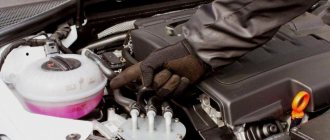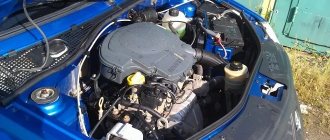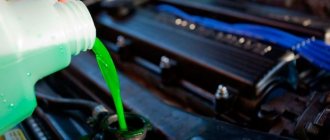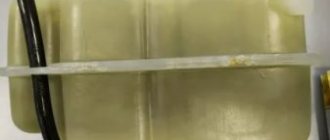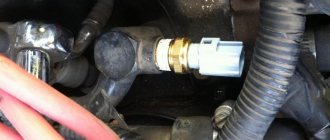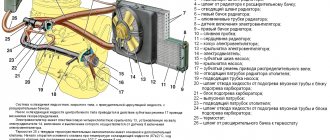Replacing coolant on VAZ 2101-VAZ 2107
Welcome! Coolant - in its essence, it plays a very important role in the cooling system of your engine, because if it is not there, then the car will not be able to work for a long time without stopping it.
And thanks to the coolant, the car’s engine is constantly cooled, thereby extending the life of your car’s engine. But over time, the liquid becomes unusable and will need to be replaced. Today we will look at the process of replacing the coolant on cars of the “Classic” family.
Note! To replace, you will need the following tools: Firstly, you will need to take a “13” wrench with you, and you will also need to stock up on an empty “10” liter container, and it is also recommended to take a clean rag with you!
Summary:
Question? What kind of coolant do you prefer to fill into your car’s engine, and why? (Write your answer in the comments)
When should you change the coolant? It must be replaced if:
- When the car travels “60 thousand km” or when it passes 2 years from the date of filling. (Whichever comes first)
- The liquid should also be replaced if it has changed its color to any other. (In most cases it changes its color to reddish)
Replacing antifreeze for VAZ 2113, 2114, 2115
In this article, we will step by step analyze the process of replacing antifreeze (coolant) using the example of a VAZ 2114, and also tell you about the frequency of replacement and the required tools to do this work yourself.
Replacement frequency
The manufacturer prescribes three conditions for replacing the fluid (depending on what comes first):
- The coolant is replaced every 80-100 thousand kilometers.
- The fluid needs to be changed every 4-5 years, regardless of mileage.
- If the color of the liquid turns brown, it needs to be replaced urgently. When the fluid loses color, its chemical composition changes, and it has a detrimental effect on the cylinder head and other parts in the cooling system made of aluminum.
Coolant selection
We recommend buying red G12 antifreeze from well-known manufacturers. For a complete replacement you need 7.5 liters, in practice it includes about 7 liters.
Tools and materials for work:
- Ratchet driver;
- Ten, thirteen socket head;
- Extension;
- Bottle;
- Container for collecting liquid;
- Funnel.
Step-by-step instruction
- Before starting work, open the tap on the stove in the cabin. This is necessary so that during replacement the liquid comes out of the heater radiator.
- Place the car on the pit. Next, unscrew the bolts securing the engine protection and casing. Wrench bolts for “10” and “13”. The location of the bolts is in the photo below.
Close the generator with a bottle and place a container to collect the liquid.
Unscrew the drain on the radiator and make sure that the fluid flows into the collection container.
In order for the liquid to come out faster, unscrew the cap of the expansion tank to allow air in.
Unscrew the bolt marked in the photo below to drain the fluid from the cylinder block cooling jackets. Before unscrewing the bolt, place a container for collection. We also recommend that you do not completely unscrew the bolt in order to collect all the liquid as much as possible.
Tighten the drain bolt on the engine block, as well as the plug on the radiator.
- Insert a funnel into the reservoir and fill the coolant to just above the level.
- Place a container to collect fluid under the hose that goes to the throttle assembly. Next, pressing on the hoses in the places marked below, expel the air from the system.
- Place and secure the hose to the throttle assembly. Next, add fluid to the level and start the engine. After warming up the engine to operating temperature, increase the crankshaft speed in jerks to 2-3 thousand (do this for 20-30 seconds). Stop the engine and let it cool. After cooling, add liquid according to the level if necessary.
The process of replacing antifreeze for VAZ 2113, 2114, 2115 is clearly shown in this video:
Let's summarize
From the instructions presented above, we can conclude that the process of replacing VAZ 2114 antifreeze is quite simple. Even a novice driver can change the fluid himself and save money on maintenance.
How to replace coolant on a VAZ 2101-VAZ 2107?
Draining: 1) First, drive the car into the pit.
Note! The car must be level, or the front must be higher than the rear, but not vice versa!
2) Then remove the crankcase protection (For information on how to remove the crankcase protection, read the article “Replacing the crankcase protection”)
3) Next, move all the way to the right, the lever that opens the supply of warm air into the car interior; in the VAZ 2106, such a lever is located on top and in the photo it is indicated by the letter “A”.
4) Next, unscrew and then remove the expansion tank plug, which is indicated by an arrow in the bottom photo.
5) Then unscrew the radiator filler cap, which is also indicated by an arrow in the photo below.
6) Now remove the drain plug located on the cylinder block.
Note! After you unscrew the drain plug located on the cylinder block, immediately place a bottle under this hole and drain all the used fluid into it!
7) Then unscrew the radiator drain plug and drain all the waste fluid from the radiator into a bottle.
 Next, unfasten the belt that secures the expansion tank, and then lift the tank up, as a result of which the remaining coolant will drain out of it and from the hose that is connected to it, which will flow through the radiator drain hole.
Next, unfasten the belt that secures the expansion tank, and then lift the tank up, as a result of which the remaining coolant will drain out of it and from the hose that is connected to it, which will flow through the radiator drain hole.
Filling: 1) First, install the radiator tank in place, and also tighten the cylinder block drain plug and the radiator drain plug.
2) Then pour new coolant into the radiator.
3) Next, pour new fluid into the radiator expansion tank.
Note! Pour new coolant into the expansion tank, just 3-4 cm above the MIN mark!
4) Next, remove any air pockets in the engine cooling system. (For information on how to do this, read the article “Removing air locks in the cooling system”)
5) Now screw the radiator cap and expansion tank cap into place.
6) Then start the car and let it idle for about 4-5 minutes, after 4-5 minutes of operation, turn off the car and add coolant to the expansion tank and radiator to the required level.
Important!
- Replace the coolant only when the engine is cold!
- The liquid is very toxic, so you should only replace it outside or in a well-ventilated area!
- After about three days have passed after the replacement, check the fluid level and, if possible, bring it to the required level!
Additional video: Don’t understand where the expansion tank is located? And you also don’t understand where the drain plug is located on the cylinder block? Watch the video below for answers to all these questions:
Leaks and problems
Cars of this model sometimes have problems associated with the failure of some parts of the cooling system, such as a thermostat or pump. If they break down, they are replaced as an assembly, fortunately they are not expensive. Also, leaking hoses or a cracked expansion tank are considered a common problem, which also needs to be replaced.
But there is another problem with the VAZ 2104, a leaking heater valve. Because of this, there may be a smell of antifreeze in the cabin, wet floor mats on the front passenger side, or the heater may not work.
In cases of boiling or seething antifreeze in the expansion tank, you need to pay attention to 2 things. This is either an air lock or a broken cylinder block gasket. When determining the problem, in the first case the stove will blow cold. In the second case, there will be either oil in the antifreeze or light smoke from the exhaust pipe.
Stages of replacing coolant VAZ 2101
On most classic Lada cars, drainage is provided from the radiator, as well as the engine. But before adding new antifreeze, it is recommended to flush the cooling system to prevent impurities from getting into the new liquid.
During the production of the VAZ 2101, a large number of modifications were produced, which were equipped with various engines. But at the moment the most popular are petrol versions with a 1.2 liter carburetor.
Before you start replacing the coolant, to avoid getting burned, you need to wait until the engine has completely cooled down. You should also avoid getting antifreeze or antifreeze on the skin, eyes or digestive organs, since the chemical composition of the liquids is toxic.
Coolant drain
Before starting the draining procedure, you should prepare tools, containers for used antifreeze, as well as new liquids for subsequent refilling. If protection is installed under the engine, it can also be removed for convenience.
Next, we perform the procedure for draining the liquid from the VAZ 2101:
- Turn the temperature regulator in the cabin to the maximum position to the right (Fig. 1).
Fig.1 Temperature control - We find the plug in the bottom left corner of the radiator and unscrew it, after placing a drain container under the radiator. (Fig.2). On older versions, this plug is not present; a fan switch sensor is installed there. To drain the antifreeze, you need to unscrew it; this can be done with a 30mm wrench.
Fig.2 Radiator drain plug - After this, unscrew the plug on the radiator filler neck, as well as on the expansion tank, to drain the liquid more quickly (Fig. 3).
Fig.3 Caps on filler necks - Unfasten the fastening of the expansion tank and lift it up (Fig. 4). In this case, the liquid will drain through the radiator drain hole. And the tank itself can be completely removed and washed.
Fig.4 Mounting the tank - To drain the coolant from the engine, you need to unscrew the drain bolt using a 13mm wrench. The bolt itself is located on the left side; you can place a watering can under it to reduce splashing of the liquid (Fig. 5).
Fig.5 Drain bolt on the engine block
Flushing the cooling system
If there are deposits in the drained liquid or there is a transition from antifreeze to antifreeze, the system should be flushed. To do this you need to do the following:
- Flush the system with plain water through the expansion tank of the VAZ 2101. The plugs must be open;
- tighten the drain plug and bolt;
- fill the system with a flushing agent (you can use Liqui Moly Kuhlerreiniger or Lavr cooling system flush) with distilled water (6-7 liters);
- start the engine. Warm up to 90 degrees;
- leave it idling for 5-10 minutes, depending on the contamination of the system;
- muffle it. Allow the engine to cool to approximately 60 degrees;
- drain the flush using the same steps as removing the old fluid;
- tighten both plugs;
- fill with distilled water to rinse the cooling system;
- start the car and warm up to 90 degrees;
- turn off and let cool to 60 degrees, drain;
- repeat steps 8, 9, 10 and 11 if necessary.
The procedure for replacing coolant in
Before you start draining the old coolant, you need to move the heating valve control lever inside the car to the extreme right position (the valve is open Photo No. 1). Unscrew the expansion tank cap and the radiator filler cap.
In the lower corner of the radiator we find the drain plug (photo 2), unscrew it and drain the liquid into a previously prepared container.
On old-style radiators there is no such plug. Instead, using the key set to “30”, you will have to unscrew the fan switch sensor. Also on the engine block, we find it and use the key to “13” to unscrew the drain plug (photo 3).
After the liquid has been drained, screw the drain plugs into place. And in order to avoid the formation of an air lock in the system, use a screwdriver to loosen the clamp and remove the rubber hose from the intake manifold fitting.
That's it, you can fill in antifreeze. As soon as liquid begins to flow out of the fitting, you can put a hose on it and tighten the clamp. Afterwards, completely fill the radiator and tighten the cap. Next, pour antifreeze into the expansion tank, the optimal level is 3-4 cm above the “MIN” mark.
We start the engine and warm it up to operating temperature. After that, turn off the engine and check the coolant level again. If necessary, add antifreeze.
If the car's cooling system is dirty, it should be washed with water or special products. The flushing procedure is the same as when replacing the fluid - drain, fill and dilute, start the engine for a few minutes and drain. And so on several times until you see clean water flowing from the radiator and engine block.
Replacement frequency, what antifreeze to fill
According to the manufacturer's recommendation, it is necessary to replace antifreeze or antifreeze on VAZ 2101 cars every 2 years or after a mileage of 60 thousand kilometers. If the car is used in more severe conditions, then it is advisable to replace it more often - every 30-40 thousand kilometers.
In addition to the recommended coolant change intervals, there are other reasons why it is necessary to change the fluid in a car's cooling system:
- Loss of properties. You can check the quality of the antifreeze used using a test strip, which is sold in the same places where the liquid itself is sold. Place the strip in the expansion tank, then pull it out. The strip comes with a color scale, according to which you can understand how much longer the car can be used before replacing the coolant.
- Change in color to red or red. This means that rust has appeared in the composition.
- The appearance of sediments, flakes and dense formations.
As a coolant for the VAZ 2101, you can use good Lukoil antifreeze. Or a lesser-known but high-quality product from Gazprom Neft. When replacing, you can also fill in antifreeze, preferably with G12 approval, it is safer for the entire system. You can also use original Lada G12 antifreeze, which is suitable for all cars of this manufacturer.
Coolant quantity VAZ 2107
So, how much antifreeze or other coolant should be poured into the VAZ 2107? According to the instructions, you need to use 9.85 liters, which means that you need to purchase 10 liters of coolant. However, what exactly should you choose – antifreeze or antifreeze? There is simply no clear answer to this question. Many drivers prefer antifreeze exclusively. It is sold ready for use or in concentrated form. In one of the articles on the Avtopub website we will definitely look at the advantages of this choice. Let's proceed to the procedure for replacing the coolant in a VAZ 2107 (VAZ 2101, VAZ 2102, VAZ 2103, VAZ 2104, VAZ 2105, VAZ 2106).
Purpose of coolant on VAZ 2107
It’s easy to guess the purpose of the coolant from its name. It serves to remove excess heat from the engine. It's simple: in any internal combustion engine there are many rubbing parts, which during operation can heat up to a temperature of 300°C. If these parts are not cooled in time, the engine will fail (and the pistons and valves will be the first to suffer from overheating). This is where coolant comes to the rescue. It is supplied to a running engine and circulates there through special channels, taking away excess heat.
Once heated, the coolant goes into the central radiator, which is constantly blown by a powerful fan. The liquid cools in the radiator and is then sent back to the cooling channels of the engine. This is how continuous liquid cooling of the VAZ 2107 engine is carried out.
Reasons for replacement
When replacing antifreeze on a VAZ 2110, you must adhere to several rules. The engine must be cold, antifreeze is a toxic liquid; when working with it, it is necessary to avoid contact with the eyes, mouth and prolonged contact with the skin.
Antifreeze, coolant (antifreeze) is a special composition of automotive fluid based on ethylene glycol. Used in the cooling system of an internal combustion engine (ICE) for operation at low ambient temperatures. There may be several reasons for replacing antifreeze:
- car mileage, 75,000 – 100,000 km. mileage;
- time interval 3 – 5 years (it is recommended to check the condition of the fluid at a car service every year before the start of the winter season with a special device);
- replacing one of the components of the cooling system, water pump, pipes, radiator, heater, etc., with such replacements, antifreeze is still drained from the cooling system and it makes sense to fill in a new one.
Cooling system VAZ 2110
About antifreeze and antifreeze
It should be said right away that dividing coolants into antifreeze and antifreeze is accepted only in Russia. To understand why this happened, you need to answer the question: what is coolant anyway?
As a rule, the base for the coolant is ethylene glycol (in rare cases, propylene glycol), to which water and a set of special additives are added to prevent corrosion. Different manufacturers have different sets of additives. And all coolants on the market today are classified according to the technologies for producing these additives. There are three technologies:
- traditional. Additives are made from salts of inorganic acids (silicates, nitrites, amines or phosphates);
- carboxylate. Additives in carboxylate fluids are obtained only from organic carbonates;
- hybrid. In this technology, manufacturers add a small percentage of inorganic salts (most often phosphates or silicates) to organic carbonate additives.
Coolant made using traditional technology is called antifreeze, and liquid made using carboxylate technology is called antifreeze. Let's take a closer look at these liquids.
Antifreeze has several advantages. Let's list them:
- protective film. The inorganic salts contained in antifreeze form a thin chemical film on the surface of the cooled parts, which reliably protects the parts from corrosion. Film thickness can reach 0.5 mm;
Of course, antifreeze also has disadvantages. Here they are:
- small resource. Antifreeze quickly becomes unusable. It needs to be changed every 40–60 thousand kilometers;
- effect on aluminum parts. The additives contained in antifreeze negatively affect the aluminum surfaces in the main radiator. In addition, antifreeze can form condensation. These factors significantly reduce the service life of aluminum radiators;
- influence on the water pump; The tendency to form condensation can also have a detrimental effect on the VAZ 2107 water pump, leading to premature wear of its impeller.
Now let's look at the pros and cons of antifreeze. Let's start with the pros:
- long service life. On average, six liters of antifreeze are enough for 150 thousand kilometers;
- temperature selectivity. Thanks to carbonate additives, antifreeze can more actively protect the engine surface that is hottest than others;
And antifreeze has only one disadvantage: high cost. A canister of high-quality antifreeze can cost two or even three times more than a canister of good antifreeze.
Taking into account all the above advantages, the vast majority of VAZ 2107 owners opt for antifreeze, since saving on coolant has never led to anything good. Almost any antifreeze, both domestic and Western, is suitable for the VAZ 2107. Most often, car owners prefer to use Lukoil G12 RED antifreeze.
Other, less well-known brands of antifreeze are Felix, Aral Extra, Glysantin G48, Zerex G, etc.
How to avoid boiling?
To prevent the antifreeze from boiling, you should choose high-boiling antifreezes, as a rule, these include ethylene glycol antifreezes. The higher the content of this substance, the higher the boiling point of antifreeze will be. Coolants that are designed for low temperatures of −40° (OZh-40) have a boiling point of - +108°, liquids designed for −65° (OZh-65) will have a boiling point of - +116°. Water and ethylene glycol in equal proportions will have a boiling point of +107°. The antifreeze that boils the most is G12-plus; it is intended for high-speed engines of the new generation.
To operate antifreeze in extreme temperatures, you should choose antifreeze with 50% ethylene glycol content.
Flushing the cooling system
Flushing the cooling system is a very important procedure, since the cooling efficiency of the VAZ 2107 engine depends on it. At the same time, many car enthusiasts prefer not to flush the cooling system, but to fill in new antifreeze immediately after draining the old one. As a result, the remnants of the old antifreeze are mixed with the new coolant, which has an extremely negative effect on its performance. That is why it is strongly recommended to flush the engine cooling system before adding new antifreeze. This can be done either with water or with the help of special compounds.
Flushing the cooling system with water
It should be said right away that it is advisable to use this washing option only when there is no good washing liquid at hand. The fact is that ordinary water contains impurities that form scale. And if the driver still decides to flush the cooling system with water, then the best choice in this situation would be distilled water.
Water rinsing sequence
- Distilled water is poured into the expansion tank of the VAZ 2107.
Flushing the cooling system with a special compound
Flushing the cooling system with a special composition is the best, but also very expensive option. Because cleaning products effectively remove residual grease, scale and organic compounds from the system. Currently, VAZ 2107 owners use two-component flushing fluids, which contain both acids and alkalis. The most popular liquid is LAVR. Cost - from 700 rubles.
Sequence of flushing the system with a special liquid
The sequence of flushing the cooling system with a special composition is practically no different from the sequence of water flushing mentioned above. The only difference is the operating time of the motor. This time must be clarified (it depends on the composition of the selected flushing liquid and must be indicated on the canister with flushing).
Replacing antifreeze on a VAZ 2107
Before starting work, let's decide on the tools and consumables. Here's what we need:
- canister with new antifreeze (6 liters);
- open-end wrenches included;
- a bucket for draining old antifreeze.
Sequence of work
- The car is installed on an overpass (or, as an option, on an inspection hole). It is better if the front wheels of the car are located slightly higher than the rear ones.
- On the dashboard you need to find a lever that controls the supply of warm air into the cabin. This lever moves to the far right position.
Video: draining coolant from a VAZ 2107
So, it is quite possible to replace the coolant on a VAZ 2107 on your own. Even a novice car enthusiast who has held a wrench in his hands at least once can cope with this procedure. All that is required for this is to strictly follow the above instructions.
How to replace antifreeze on a VAZ 2107?
The engine cooling system is an important part of every car, through which the normal operation of the engine is ensured. A significant part of the cooling system is devoted to refrigerant or coolant, which can be presented in the form of antifreeze (in most cases), antifreeze or distilled water. During the operation of any car, including the VAZ 2107, it is important to promptly replace the coolant, which will improve the efficiency of the cooling system. In this issue, we will look in more detail at how to correctly replace antifreeze on a VAZ 2107, what is required for this and where to start.
Time to replace antifreeze on a VAZ
Antifreeze has its own production period, after which the liquid must be replaced. Antifreeze does not always lose its properties only because of the passage of time: engine corrosion can also be the reason for replacement. This is why antifreeze can change color to red, orange or brown. For the VAZ 2107 car model, antifreeze, according to the operating instructions, must be replaced every forty-five thousand kilometers or once every two calendar years. If this is not done, the car owner may encounter technical problems, since antifreeze performs the following functions in the car:
- Maintains optimal engine temperature
- Keeps transmission temperatures low
- Helps warm the car interior in winter
The condition of antifreeze can be assessed by studying its color at the current time. To do this, you need to look into the expansion tank and understand what color the coolant is. If the antifreeze was poured not so long ago, its color will be bright blue. If the liquid has a characteristic dark or reddish color, then you should think about replacing it.
Replacing the coolant: why is this event being carried out?
The cooling system of modern cars is presented in the form of a liquid-type system, which means heat is removed from the car engine through liquid. The coolant circulates through the system, removing heat from the engine and cooling in the radiator. The pump or water pump redirects the cooled portion of the liquid to the engine to cool the latter again. The heat exchange process occurs continuously while the car engine is running and the pump is rotating.
As the coolant is constantly exposed to different temperatures, it loses its properties over time. When antifreeze loses its properties, its boiling point decreases and approaches the boiling point of ordinary water. Most often this happens after a mileage not exceeding 60 thousand km. It is at this mileage that it is recommended to completely replace the antifreeze in order to avoid unforeseen and undesirable consequences. Before we begin the replacement, let’s find out how to properly drain antifreeze from a VAZ 2107.
How to properly drain used fluid
To drain antifreeze from a VAZ 2107 car, simply opening the tap is not enough, through which all the liquid will flow out of the system. Both antifreeze and antifreeze are toxic substances, so when working with them you should follow safety rules. Before draining, it is necessary to prepare a container into which the waste will be drained. The volume of such a container should not be less than 10 liters. The best option for such purposes is a trough or basin.
It is easy to carry out the work without an inspection hole, so it is recommended to install the car on the handbrake, and then place a trough or other container under the engine. We begin the process of draining the liquid, for which the following steps are performed:
- The first step is to open the hood, then unscrew the cap from the expansion tank. This is necessary in order to reduce the pressure in the system, thereby speeding up the process of draining the waste. It is also recommended to unscrew the cap on the radiator.
- It is necessary to open the heater tap from inside (move the lever to the “warm” position) in order for the coolant to drain from the heater radiator.
- The next step requires unscrewing the plug bolt, which is located at the bottom of the cylinder block.
- Now you can start unscrewing the drain plug. located on the radiator. After unscrewing it, drain all the used fluid into a container, which may take up to 10 minutes.
- At the next stage, you need to loosen the fastening of the expansion tank, and then lift the latter up to drain the remaining liquid from it. How much antifreeze will be in the system depends on how often the car owner added it there.
The capacity of the cooling system of VAZ-2107 cars is just over 8.5 liters, so you need to wait until the last drop flows out. While the antifreeze is draining, you can prepare a new canister that will be poured into the system.
It is important to know! It is strictly forbidden to start the car when there is no antifreeze in the system.
Features of filling coolant
During the process of replacing the coolant, you can perform the procedure of changing the sealant or clamps on the pipes if leaks were noticed earlier. To do this, it is necessary to remove the pipes, check their integrity, remove any old sealant, then apply a new one and put it back in place. If the pipes have obvious defects, then it is better to replace them immediately, so that after a while the new antifreeze does not end up under the car.
Before adding a new type of antifreeze, you should tighten the drain bolt on the cylinder block, as well as the lower plug on the radiator. Don't forget to complete these steps before you begin the pouring process. We recommend doing the filling as follows:
- Before filling, unscrew the sensor located between the spark plugs of the 3rd and 4th cylinders, slightly higher, from the cylinder block. This will prevent the formation of an air lock in the car's cooling system;
- now antifreeze is poured into the VAZ 2107 through the hole in the radiator until it flows out of the hole from the sensor in the block in an amount of about 5 liters;
- screw the sensor into place and continue pouring;
- It is necessary to pour until the radiator is completely filled. You can additionally move the pipes to release air from them;
- After filling the radiator, you need to close its cap and add coolant into the expansion tank to the range from “MIN” to “MAX”.
It is important to know! Replace the coolant on your car only when the engine is cool. Antifreeze is very toxic, so inhaling its vapors can affect your well-being.
On VAZ 2107 cars, the injector and carburetor differences in the cooling system are insignificant. The only difference is that the temperature control system sensor is installed on the injector and the throttle body is heated. The carburetor engine of the "seven" has a more simplified cooling system, but they work on the same principle. There is no difference in the coolant capacity of the cooling systems of carburetor and injection engines. Above is a video about how antifreeze is replaced on a “seven”.
Why do they change antifreeze?
In the process of constant temperature exposure, antifreeze may lose its properties. That is, first of all, its boiling point decreases and becomes equal to the boiling point of ordinary water. Secondly, such fluid can easily freeze and cause a cracked reservoir, and in the worst case, a cracked cylinder block. That is why antifreeze must be changed at least once every six months during seasonal vehicle maintenance in order to avoid undesirable consequences.
- Under no circumstances should you drain antifreeze onto the floor in your garage or yard. Since this substance is toxic, its fumes can enter the human respiratory system. Do not underestimate the chemical composition of antifreeze. After all, one glass of such “muck” can easily kill a person.
- As you already understand, you should not allow antifreeze to get into your mouth. Many drivers do a very dangerous test when determining the type of liquid poured into the expansion tank: they dip their finger into this tank and then try it with their tongue. If it was sweet, then it is 100% antifreeze, and if not, and it gives off scale, then it is the most ordinary water, which has already been overheated more than once.
- If antifreeze gets into your eyes, hands or other parts of the body, be sure to rinse these areas under running cold water and call a specialist doctor. Do not forget that antifreeze is, first of all, poison for humans, and only then a coolant for the engine.
- After completing work related to repairing the cooling system, you must thoroughly wash your hands. In addition, it is strictly prohibited to eat anything while performing this work.
Once you have prepared everything you need, place the car on a level surface, or best of all, on an inspection hole and place a trough under the radiator. Open the hood and unscrew the cap from the expansion tank. This is necessary to make it easier for the liquid to come out. After this, unscrew the tap located on the radiator.
If you have an old-style copper radiator installed, then this tap acts as a fan activation sensor and is designed for a 30 wrench. To remove it, you first need to disconnect the contact wires from it and then unscrew it. Now all that remains is to wait until all the coolant has completely drained out of the radiator. To speed up this procedure, you can shake the front of the car.
Purpose of coolant on VAZ 2107
It’s easy to guess the purpose of the coolant from its name. It serves to remove excess heat from the engine. It's simple: in any internal combustion engine there are many rubbing parts, which during operation can heat up to a temperature of 300°C. If these parts are not cooled in time, the engine will fail (and the pistons and valves will be the first to suffer from overheating). This is where coolant comes to the rescue. It is supplied to a running engine and circulates there through special channels, taking away excess heat.
Once heated, the coolant goes into the central radiator, which is constantly blown by a powerful fan. The liquid cools in the radiator and is then sent back to the cooling channels of the engine. This is how continuous liquid cooling of the VAZ 2107 engine is carried out.
About antifreeze and antifreeze
It should be said right away that dividing coolants into antifreeze and antifreeze is accepted only in Russia. To understand why this happened, you need to answer the question: what is coolant anyway?
As a rule, the base for the coolant is ethylene glycol (in rare cases, propylene glycol), to which water and a set of special additives are added to prevent corrosion. Different manufacturers have different sets of additives. And all coolants on the market today are classified according to the technologies for producing these additives. There are three technologies:
- traditional. Additives are made from salts of inorganic acids (silicates, nitrites, amines or phosphates);
- carboxylate. Additives in carboxylate fluids are obtained only from organic carbonates;
- hybrid. In this technology, manufacturers add a small percentage of inorganic salts (most often phosphates or silicates) to organic carbonate additives.
Coolant made using traditional technology is called antifreeze, and liquid made using carboxylate technology is called antifreeze. Let's take a closer look at these liquids.
Antifreeze has several advantages. Let's list them:
- protective film. The inorganic salts contained in antifreeze form a thin chemical film on the surface of the cooled parts, which reliably protects the parts from corrosion. Film thickness can reach 0.5 mm;
Of course, antifreeze also has disadvantages. Here they are:
- small resource. Antifreeze quickly becomes unusable. It needs to be changed every 40–60 thousand kilometers;
- effect on aluminum parts. The additives contained in antifreeze negatively affect the aluminum surfaces in the main radiator. In addition, antifreeze can form condensation. These factors significantly reduce the service life of aluminum radiators;
- influence on the water pump; The tendency to form condensation can also have a detrimental effect on the VAZ 2107 water pump, leading to premature wear of its impeller.
Now let's look at the pros and cons of antifreeze. Let's start with the pros:
- long service life. On average, six liters of antifreeze are enough for 150 thousand kilometers;
- temperature selectivity. Thanks to carbonate additives, antifreeze can more actively protect the engine surface that is hottest than others;
And antifreeze has only one disadvantage: high cost. A canister of high-quality antifreeze can cost two or even three times more than a canister of good antifreeze.
Taking into account all the above advantages, the vast majority of VAZ 2107 owners opt for antifreeze, since saving on coolant has never led to anything good. Almost any antifreeze, both domestic and Western, is suitable for the VAZ 2107. Most often, car owners prefer to use Lukoil G12 RED antifreeze.
Other, less well-known brands of antifreeze are Felix, Aral Extra, Glysantin G48, Zerex G, etc.
Flushing the cooling system
Flushing the cooling system is a very important procedure, since the cooling efficiency of the VAZ 2107 engine depends on it. At the same time, many car enthusiasts prefer not to flush the cooling system, but to fill in new antifreeze immediately after draining the old one. As a result, the remnants of the old antifreeze are mixed with the new coolant, which has an extremely negative effect on its performance. That is why it is strongly recommended to flush the engine cooling system before adding new antifreeze. This can be done either with water or with the help of special compounds.
Flushing the cooling system with water
It should be said right away that it is advisable to use this washing option only when there is no good washing liquid at hand. The fact is that ordinary water contains impurities that form scale. And if the driver still decides to flush the cooling system with water, then the best choice in this situation would be distilled water.
Water rinsing sequence
- Distilled water is poured into the expansion tank of the VAZ 2107.
Flushing the cooling system with a special compound
Flushing the cooling system with a special composition is the best, but also very expensive option. Because cleaning products effectively remove residual grease, scale and organic compounds from the system. Currently, VAZ 2107 owners use two-component flushing fluids, which contain both acids and alkalis. The most popular liquid is LAVR. Cost - from 700 rubles.
Sequence of flushing the system with a special liquid
The sequence of flushing the cooling system with a special composition is practically no different from the sequence of water flushing mentioned above. The only difference is the operating time of the motor. This time must be clarified (it depends on the composition of the selected flushing liquid and must be indicated on the canister with flushing).
Replacing antifreeze on a VAZ 2107
Before starting work, let's decide on the tools and consumables. Here's what we need:
- canister with new antifreeze (6 liters);
- open-end wrenches included;
- a bucket for draining old antifreeze.
Sequence of work
- The car is installed on an overpass (or, as an option, on an inspection hole). It is better if the front wheels of the car are located slightly higher than the rear ones.
- On the dashboard you need to find a lever that controls the supply of warm air into the cabin. This lever moves to the far right position.


